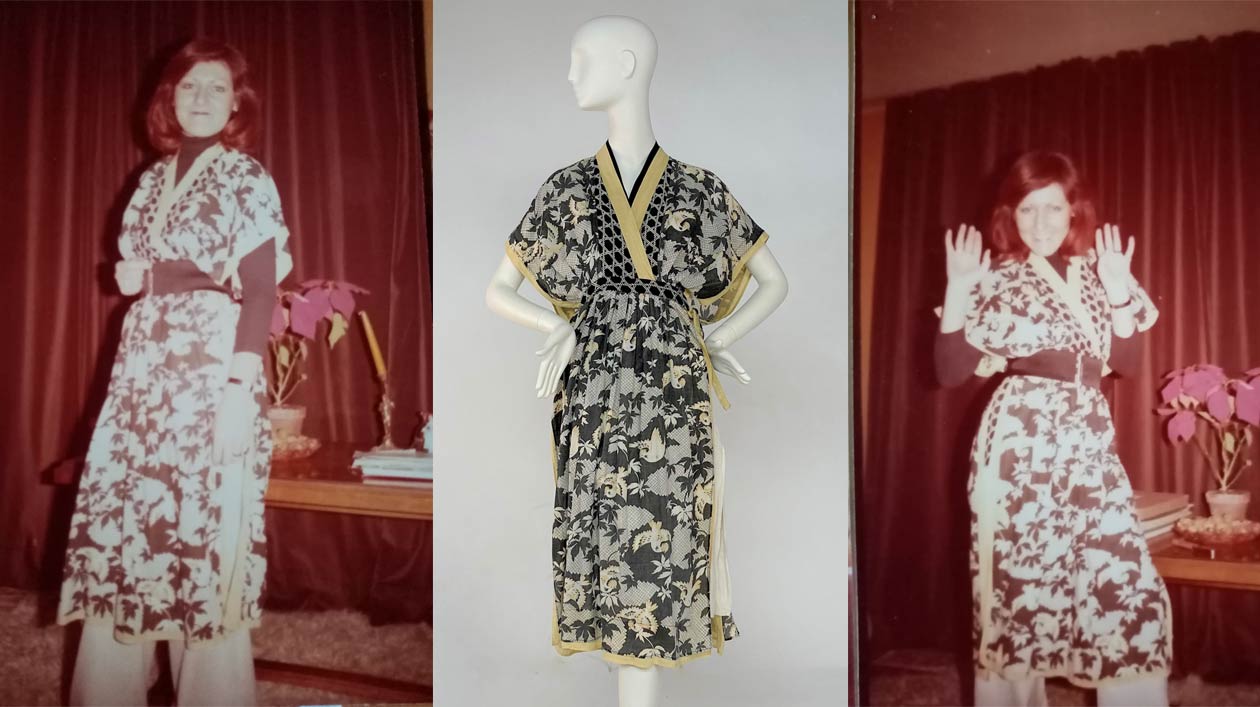Fashionable New Acquisition in the Kunstgewerbemuseum: A Kimono Dress by Designer Kenzō Takada
News from 07/29/2021
A few weeks ago, a kimono dress created by Japanese designer Kenzō Takada was donated to the Kunstgewerbemuseum (Museum of Decorative Arts) – Staatliche Museen zu Berlin. As fashion curator Katrin Lindemann explains, the garment was long forgotten by its owner before eventually making its way to Berlin.

Ms. Lindemann, you recently received a very special package containing a kimono dress created by Kenzō Takada. Who was Kenzō?
Katrin Lindemann: Kenzō Takada was born in 1939 near Osaka, Japan. He founded his company in Paris in 1970, and in the same year, he opened his first boutique there under the name Jungle Jap. The label's trademark features were unconventional combinations of colors and patterns as well as multihued jungle motifs. Today, the label is best known for its logo of a roaring tiger with the word KENZŌ in its mouth. Kenzō’s designs were based on the idea of merging Asian and European cultural influences. So it was natural that he would open Western doors for Japanese fashion design and pave the way for designers such as Yōji Yamamoto and Rei Kawakubo. At the start of his career, Kenzō created the pejorative sounding label “JUNGLE JAP. Paris” for his designs. But beginning around 1972, he began putting his name on the brand’s labels, too, with his portrait at the center: “KENZŌ JAP. Made in France.”
How did the gift come about?
Lindemann: That label can be found in the kimono dress, too, and it tells us, along with the story of its former owner, Brigitte Marchl, that this must be a very early prêt-à-porter item from the designer. The photos showing Ms. Marchl in the Kenzo dress were taken around 1974. Its colors are somewhat more vibrant in those images. By now, the dress – evidently a favorite – shows evidence of having been worn quite often. Ms. Marchl no longer recalls how she came to buy it or when. She was very successful professionally at the time and routinely visited designer boutiques.
Many years later, on hearing of Kenzō Takada’s death in October 2020, she remembered that she still owned one of his pieces. She then offered it to the Kunstgewerbemuseum as a gift.
What makes the dress so special?
Lindemann: At first glance, Kenzō's kimono dress seems quite simple, but it is indeed very special. It consists of a single-colored, cream-white slip and a lightweight cotton outer garment with a floral pattern. The outer piece is adorned with Japanese-style black-and-white maple leaves combined with flying birds against a background inspired by the shibori technique. The neckline, which overlaps on each side across the chest, is trimmed with a light-yellow facing – in the style of a kimono – an element repeated in black on the slip so that both layers are visible when worn. The yellow facing is used as edging around the entire outer garment. The kimono sleeves are cut very short and wide, and the sleeves and top are separated from the skirt by a black band with white ornamentation; the open sides are brought together at the waist with two bands. A strip with the same pattern is repeated alongside the edge facing at the neckline. Ms. Marchl repurposed the dress by wearing only the outer garment, in combination with a black turtleneck sweater, beige bell-bottom trousers, and a wide, black waist belt.
What are the next steps?
Lindemann: For the catalog, more information is still needed on when the dress was created and the exact collection it belonged to. The literature in the Lipperheide Costume Library has been very helpful for the research into those matters. It has been possible, for example, to determine the period of time in which this label was used, which allows for an initial approximate and verifiable dating of the dress. The dress narrows a big gap that we have in our collection in the field of Japanese fashion design from the latter half of the 20th century, so I am very pleased with this compelling addition to our fashion collection.
The interview was conducted by Elena Then.

